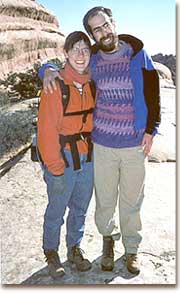David Goldhaber-Gordon
David Goldhaber-Gordon knows a thing or two about chocolate. While he served as the chocolate steward for Harvard's Society of Fellows, it was his burden to select just the right truffles and bar chocolates for weekly Society functions. For those unfortunate Fellows who lacked a taste for the good stuff, Goldhaber-Gordon was kind enough to provide white chocolate (which, he points out, is not chocolate in the true sense), candied fruits, and other treats. “For special occasions I would order chocolate from La Maison du Chocolat in New York, which imports chocolates from Paris,” says Goldhaber-Gordon, “But we were extremely fortunate to have in Cambridge a chocolatier called Burdick's. Larry Burdick produces fabulous chocolates in New Hampshire, as good as any I've tasted in Europe, and his shop in Cambridge also serves what may be the world's most serious hot chocolate.”
Although a box of fine chocolates might tempt his palate, a box of electrons is more likely to pique his professional interest. Goldhaber-Gordon's research at Stanford's Geballe Lab for Advanced Materials aims to discover the characteristics of electrons trapped in small structures. “I've been interested in studying between one and a hundred electrons in a box,” explains Goldhaber-Gordon, “and seeing, as I add one electron at a time, how the electrons rearrange, or what spin states they take on.”

Photo: Sara Goldhaber-Fiebert
David and wife Ilana Goldhaber-Gordon pose during a winter hike through the arid Utah wilderness. Ilana is on the verge of earning her biology PhD at MIT, and presented a paper entitled "MuA Transposase: Organizing Two Reactions With One Active Site" at the March 2002 APS meeting that featured David's George E. Valley Prize ceremony."
Although he casually refers to the structures he studies as boxes, bear in mind that his boxes can take on myriad shapes, from tubes to pancakes to spheres to pyramids, and may be built of a wide array of metals and semiconductors. Gallium arsenide is one of his favorite materials because, Goldhaber-Gordon says, “It is gloriously boring. It's electronically so simple a material that I can almost pretend the electrons are in vacuum, so measurement results tell us about the electrons themselves, independent of the underlying material.”
It was his interest in confined electrons that garnered Goldhaber-Gordon the inaugural George E. Valley Prize, which recognizes an outstanding physicist under the age of thirty. The prize was awarded at the March 2002 American Physical Society meeting, and cited Goldhaber-Gordon's contribution to the understanding of an unusual relationship between temperature and resistivity in some metals. Typically, as a metal is cooled its resistivity (the measure of the metal's resistance to the flow of electrons) decreases - as it should according to well-established physical models. In some cases, however, as the temperature falls the resistivity falls initially, but eventually begins to rise again. A theory put forth by physicist Jun Kondo - a few years before Goldhaber-Gordon was born - seemed to explain the effect well. Still, no one had managed to confirm some important consequences of Kondo's hypothesis.
Goldhaber-Gordon solved this problem with some of his tiny electron boxes, which can serve as artificial analogs of impurity atoms in a metal. “I was able to make detailed observations of a single impurity while tuning coupling strength, energy levels, and all the other relevant parameters of the system,” he explains. “This tunability enabled me to verify 30-year-old predictions about the strength of the Kondo interaction as a function of various parameters.”
When Goldhaber-Gordon accepted the prize for his Kondo Effect work, he was, as you might imagine, surrounded by proud family members. Many important physicists were in the room as well - also to be expected. At this year's ceremony, however, several attendees fit both family and peer categories simultaneously. The overlap reflects the fact that Goldhaber-Gordon's family is peppered with esteemed physicists. His father Alfred is an expert on monopoles, father-in-law Robert Gordon is a chemical physicist, his grandfather Maurice continues to author papers on the foundations of the Standard Model, and his late grandmother Gertrude contributed significantly to our understanding of nuclear structure. Then there is his great uncle Gerson and Gerson's late wife Shulamit, both distinguished nuclear/particle physicists, and his uncle Michael who studied particle physics but moved on to explore the sociology of technology. Goldhaber-Gordon is, therefore, the seventh PhD physicist in his family, eighth if you count his father-in-law. Despite his physics lineage, Goldhaber-Gordon insists that his profession was hardly preordained. “My parents made it clear that they wanted me to do what made me happy, and not that they only wanted me to be a physicist.”
The lack of external pressure in childhood may partly explain Goldhaber-Gordon's playful attitude toward his work and a broad spectrum of personal interests, including board games, music from Bela Fleck to Béla Bartók, biophysics, particle physics, and of course the science of chocolate. A love of board games and literature meshes well with his observance of religious holy days, says Goldhaber-Gordon, “I do a lot of my reading and game playing on Shabbat, sundown Friday through sundown Saturday.” It's a custom that helps the young physicist to maintain a reasonable balance between work and home life. “I promised myself I would have a life while I was a junior faculty member because, as much as I love my work, it's not worth it to throw myself into it so thoroughly that I become unhappy for years.” Although he admits that the demands of setting up a new lab at Stanford have monopolized his time for the last six months or so, Goldhaber-Gordon expects that he will soon get back to the family, games, books, and hobbies that complement his academic pursuits. And you can bet that he'll probably take a moment to enjoy some really good chocolate.











